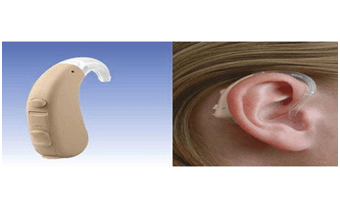Types of Hearing Aids
Hearing Aids (or a Hearing Machine) is like a small wireless loudspeaker, that can be adjusted inside the ear to enable hearing of sound by amplifying it. It is also fitted with a switch that helps increasing or to decrease the volume according to the individual’s hearing capacity. Hearing aids are available in various types depending on the size, placement (in or on the ear), and the sound processing. Below are the major 6 types of Hearing Aid Devices
Behind the Ear (BTE)
These hearing aids are made to sit behind the ear by hooking over the top of the ear and can be made to rest behind the ear and hence are named so. It possesses a plastic mold and fits inside the outer ear and then it directs the sounds to the ear. An improved version of it comes in a different mold called a Mini BTE that fits entirely behind the ear. There is a narrow tube that goes into the ear canal, helping keep the earwax from building up and ensures hearing the clear desired sound.

A customized ear tube connects the hearing aid that fits in the ear canal. The sound travels into the ear from the BTE hearing aid through the earmold. The Behind- the- ear (BTEs) works best for the individuals with mild to severe hearing loss and are generally considered appropriate for the people of all ages and types of hearing loss they suffer from. The BTE provides a wide scope for an individual to opt for a varied range of sizes, shapes, and colours.
Receiver In Canal
Receiver-in-Canal (RIC) has an electronic component that connects to a receiver in the ear canal through a tiny wire. RIC is equipped with a small, soft tip that can sit inside the ear canal without having to seal them. These hearing aids allow low frequency sounds to enter the ear naturally and amplify them. These are also suitable for people with mild to profound hearing loss. But for opting a pair of hearing aid one must consult an audiologist as not all hearing aids serve to the same degree; they are customized as individual-centric addressing specific types of hearing loss.

The Receiver-in-the-canal (RIC) hearing aids are sometimes also referred to as receiver-in-the-ear (RITE) or canal receiver technology (CRT). These are smaller than standard BTE models and can be easy to handle and operate upon. They are also equipped with many features. They can be easily worn behind the ear and are very comfortable to carry. Unlike the BTE, they provide superior listening experience with improved sound quality. In RIC, the “receiver” is located outside the housing and positioned near the eardrum. In terms of styles, the receiver-in-canal (RIC) and receiver-in-the-ear (RITE) are similar in styles with a behind-the-ear (BTE) hearing aid with the speaker or receiver in the canal or in the ear.
RICs are the recent advancement in hearing aids and are suitable for individuals suffering from severe to mild hearing loss. The RIC model is very discrete works effectively as can be operated fully automatically.
In The Ear (ITE)
An ITE hearing aid can be used in the case of mild to moderately severe hearing loss. But the small size of these hearing aids gives a negligible scope to adjust and remove them. Such types of hearing aids are not suitable for children or senior citizens who might have problems adjusting with very small devices. These come in a plastic case that holds the electronic machinery inside it. An In-the-ear (ITE) hearing aids fit completely inside the outer ear. It can be used on an everyday basis or maybe for several months at a time. It comes two customized styles- one that fills in the outer ear (in the vowel shaped area of the ear) and in the lower part (half shell).

In The Canal (ITC)
These hearing aids fit inside the ear and are not seen easily, therefore it is known as ‘in-the-canal (ITC) hearing aid fits specifically in the ear canal. The smaller size and the presence in the canal make them nearly hidden in the ear. Based on an impression of the ear canal and the surrounding area, these hearing aids are customized based on the impression of the ear canal and the surrounding area. They are considered as cosmetically appealing.

These are more powerful than their size and are recommended to individuals with mild to severe/profound hearing loss. The dual microphones help improving speech understanding in noise. It also provides wireless and telecoil options.
Completely in Canal (CIC)
In consonance to their names, the Completely-In-Canal (CIC) hearing aids are worn completely in the ear canal and the most discrete and affordable options. They come in a variety of skin tones and not distinctly noticeable when worn out. They are enabled with transparent wire and offers maximum comfort and sound quality. These are custom fit as per the unique to ear anatomy and canal impression. They are easy to handle and worn out likewise. The CIC’s location in the ear canal helps with using the telephone, also the preservation of the natural acoustics provided by the external ear (pinna). CIC helps with localizing the direction of sound from in front and behind you.

Invisible in Canal
The Invisible-in-Canal (IIC) is the smallest hearing aids that can be fit deep inside the ear so much so that they are almost invisible. They are non-surgically inserted (by a doctor) deep into the ear canal and almost undetectable by others, so are well-hidden! Therefore, they are invisible externally. These hearing aids are very effective and come in a small magnetic tool that opens into the ear canal.

